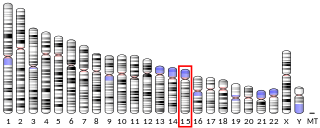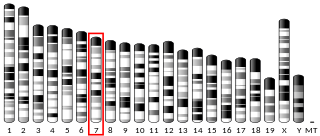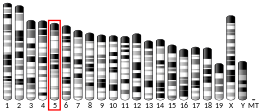
AP-2 complex subunit mu is a protein that in humans is encoded by the AP2M1 gene.

AP-2 complex subunit alpha-1 is a protein that in humans is encoded by the AP2A1 gene.

AP-1 complex subunit mu-1 is a protein that in humans is encoded by the AP1M1 gene.

AP-1 complex subunit gamma-1 is a protein that in humans is encoded by the AP1G1 gene.

AP-1 complex subunit beta-1 is a protein that in humans is encoded by the AP1B1 gene.

AP-3 complex subunit delta-1 is a protein that in humans is encoded by the AP3D1 gene.

AP-1 complex subunit mu-2 is a protein that in humans is encoded by the AP1M2 gene.

AP-3 complex subunit beta-1 is a protein that in humans is encoded by the AP3B1 gene.

AP-1 complex subunit sigma-1A is a protein that in humans is encoded by the AP1S1 gene.

AP-1 complex subunit gamma-like 2 is a protein that in humans is encoded by the AP1G2 gene.

Vacuolar protein sorting-associated protein 26A is a protein that in humans is encoded by the VPS26A gene.

AP-3 complex subunit mu-1 is a protein that in humans is encoded by the AP3M1 gene.

AP-3 complex subunit sigma-2 is a protein that in humans is encoded by the AP3S2 gene.

AP-2 complex subunit sigma is a protein that in humans is encoded by the AP2S1 gene.

AP-3 complex subunit sigma-1 is a protein that in humans is encoded by the AP3S1 gene.

AP-3 complex subunit beta-2 is a protein that in humans is encoded by the AP3B2 gene.

AP-4 complex subunit beta-1 is a protein that in humans is encoded by the AP4B1 gene.

AP-4 complex subunit epsilon-1 is a protein that in humans is encoded by the AP4E1 gene.

AP-4 complex subunit sigma-1 is a protein that in humans is encoded by the AP4S1 gene.
Clathrin adaptor proteins, also known as adaptins, are vesicular transport adaptor proteins associated with clathrin. These proteins are synthesized in the ribosomes, processed in the endoplasmic reticulum and transported from the Golgi apparatus to the trans-Golgi network, and from there via small carrier vesicles to their final destination compartment. The association between adaptins and clathrin are important for vesicular cargo selection and transporting. Clathrin coats contain both clathrin and adaptor complexes that link clathrin to receptors in coated vesicles. Clathrin-associated protein complexes are believed to interact with the cytoplasmic tails of membrane proteins, leading to their selection and concentration. Therefore, adaptor proteins are responsible for the recruitment of cargo molecules into a growing clathrin-coated pits. The two major types of clathrin adaptor complexes are the heterotetrameric vesicular transport adaptor proteins (AP1-5), and the monomeric GGA adaptors. Adaptins are distantly related to the other main type of vesicular transport proteins, the coatomer subunits, sharing between 16% and 26% of their amino acid sequence.

















